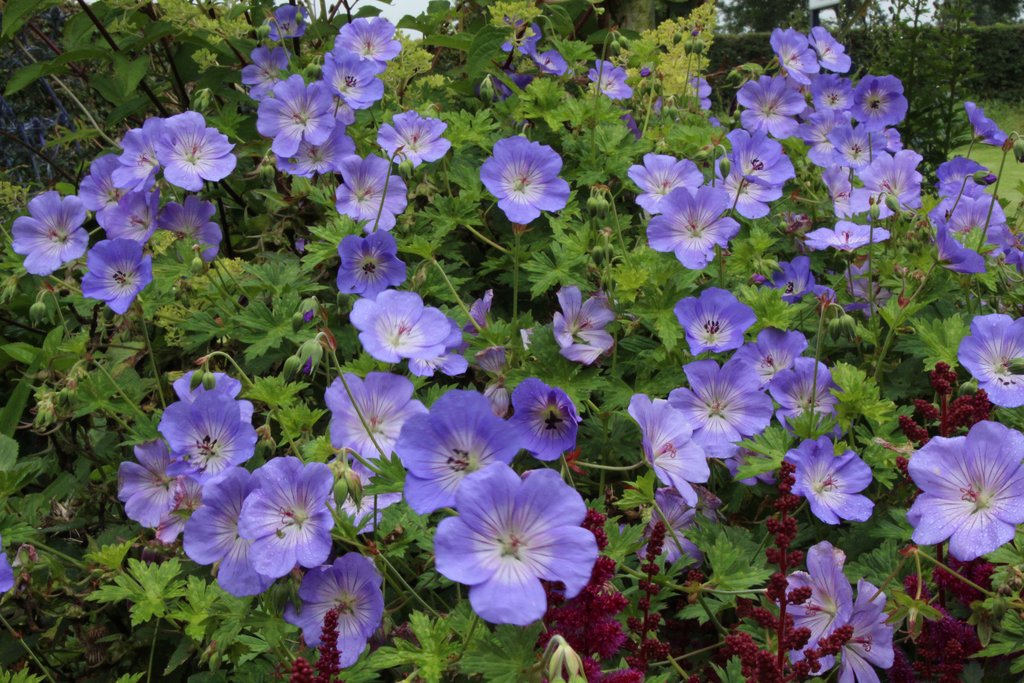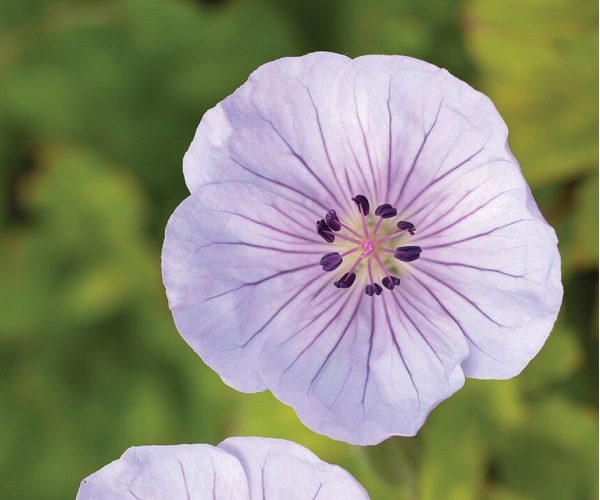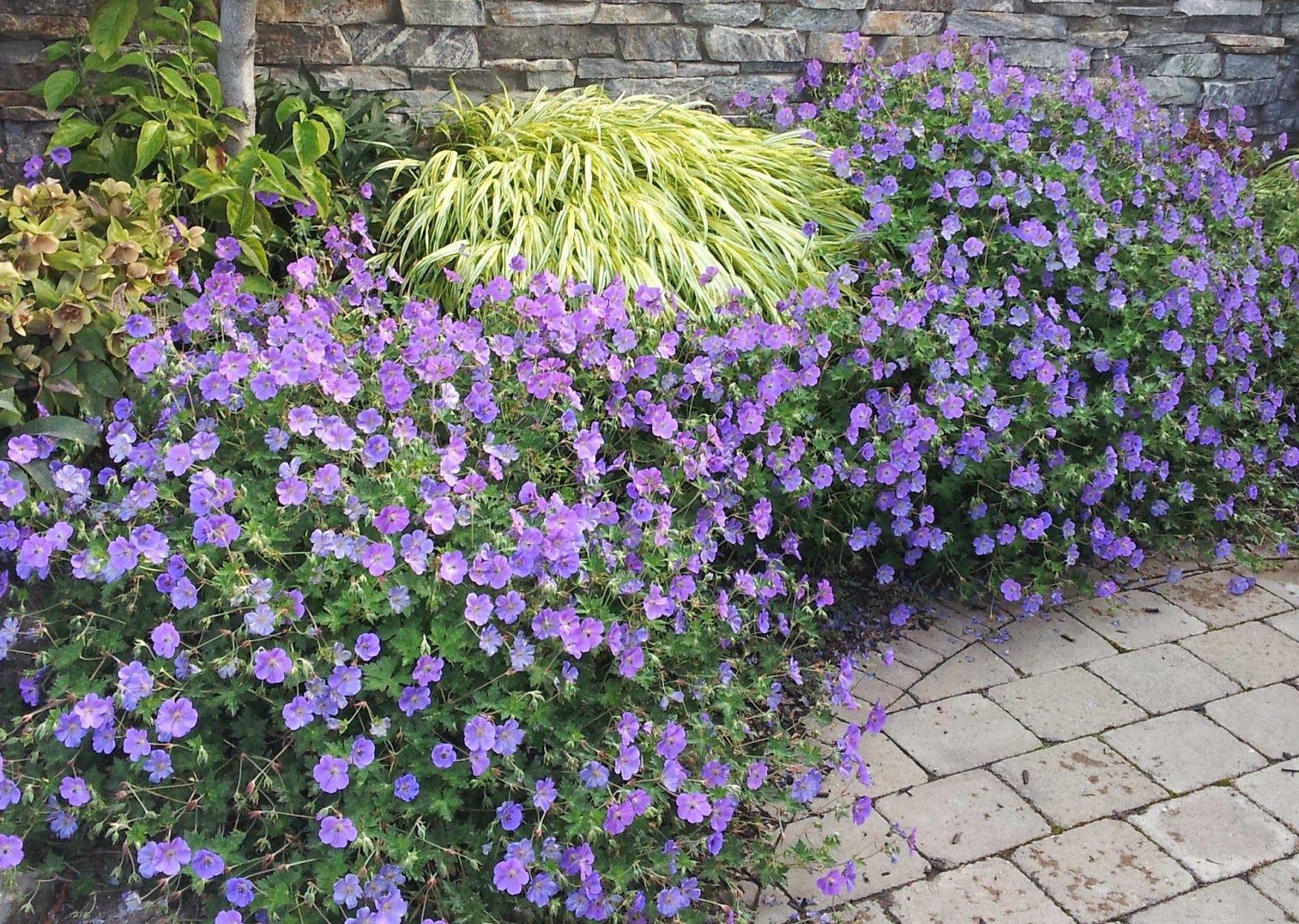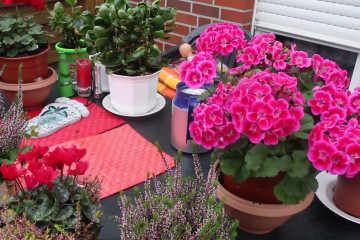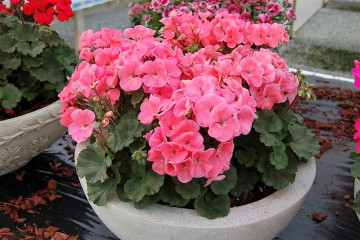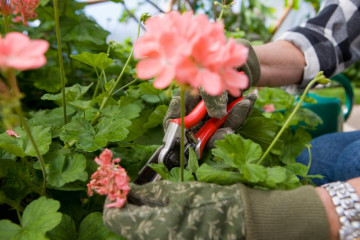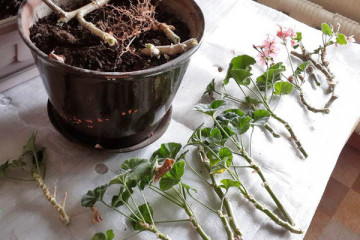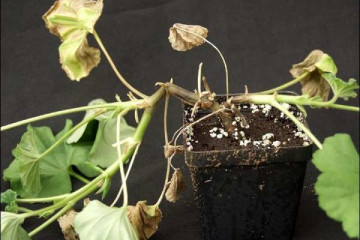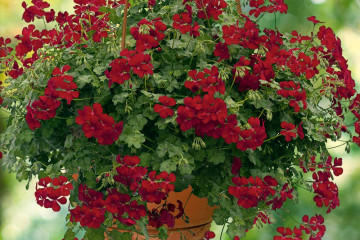Geranium Roseanne hybrid - planting and care
Content:
A brightly blooming and unpretentious perennial - Roseanne geranium - firmly occupies the position of a favorite indoor and garden flower. The plant of the century in 2013 was named by representatives of the Royal Society of Florists of Great Britain. The most popular is only peony geranium (pelargonium), as well as such a novelty of European selection as rose geranium.
Description of the flower
In 1989, two different types of garden geraniums were crossed by a spouse-florist named Roseanne and Donald Waterrer in a completely random way. The resulting copy acquired completely unique features that the public liked very much.
Each bush is a highly overgrown ground cover plant with numerous shoots, the length of which can reach 1 m. The bush itself rises only 30-50 cm above the garden bed. Roseanne geraniums are not planted tightly, only 3-4 specimens per 1 m².
What Rozanne Geranium Looks Like
It is known that the new species was obtained by crossing a large-flowered herbaceous Himalayan geranium (Geranium Himalayense) and a variant variety of Wallich geranium (Geranium Wallichianum Buxton's Variety). The plant with this description went on sale thanks to the Blooms of Bressingham nursery in 2000.
The flower, like that of pink pelargonium, has a large size (up to 5 cm in diameter) and a bell-blue tint, in which a purple tone and a white tint in the core may be present. On the petals up to five purple strokes. The colder the weather, the bluer the corolla tone. Stems are long, recumbent. The leaves are strongly dissected toothed; when touched, they emit a strong pleasant aroma.
Common varieties of garden geranium Roseanne
Among the most popular varieties bred by breeders based on the Roseanne geranium are the following specimens:
- Azure Rush. The corolla has a pale purple hue with an almost white core. The bush from the classic Roseanne differs in greater compactness (height up to 41 cm, width - up to 70 cm). The diameter of the flower is up to 6 cm. It blooms from May to October;
- Lilac Ice. It is not for nothing that the variety was called Lilac Ice, flowers up to 2.5 cm in diameter have a cold blue tint, which can change depending on the weather and air temperature. A compact bush with an average height of 30-50 cm. Prefers partial shade, blooms from June to July.
The demand for seedlings or garden geranium seeds is only increasing. Already, the assortment of large and well-known nurseries impresses with a variety of varieties and varieties:
- geranium Ballerina;
- ash, or gray;
- dalmatian;
- Cambridge geranium (Cambridge);
- cantabrian.
A real hit is the golden hue on the leaves or flowers, as well as the terry edges of the petals. The buds can be mini-roses or tulip-shaped. The foliage can take on a pale green lighter shade, richer like an apple, and darker to chocolatey.
Planting and caring for Roseanne geraniums
The beauty of this perennial is that you can grow it anywhere: in the garden, in flower beds, in containers and flowerpots, on the windowsill. The main condition is at least 6 hours.a day of bright light.
Temperature
Perennial home geraniums can grow for many years in the garden without requiring close attention. In summer, it tolerates heat up to 30 ° С, and in winter - frost down to -28 ° С.
Lighting
The place for planting is chosen so that the brightest sun rays fall on the flower in the morning and in the afternoon. It is best to provide shading for the bushes at noon. In this case, the petals will not fade.
Watering
In open areas, the bushes are watered as the soil dries out. It is believed that garden geranium is moisture-loving, but does not tolerate waterlogging. If the plant is transplanted into a flowerpot, then watering is carried out through the pallet.
Spraying
Spraying the Roseanne geranium is not required. Splashing water on leaves during hot weather can cause stains. Petals with drops on them will inevitably get burned.
Humidity
Dry sultry air will not harm perennials. It is best for him with an air humidity of about 50-60%. But even with prolonged damp weather, there will not be much harm, the main thing is not to be zealous with watering.
Priming
The plant is absolutely not demanding to the soil, its chemical composition, structure. Prefers loose, rich in nutrients, but will show good results on clay or sandy loam.
Top dressing
Fertilizers (organic and mineral) are recommended to be applied with watering in spring (from May).
The emphasis is on preparing geraniums for future long flowering. For this she needs manganese, phosphorus, potassium. Do not get carried away with nitrogen. Roseanne looks most beautiful with a small green mass and numerous flowers.
Wintering features
For the winter, remove all dried parts, and a 5-10 cm layer of mulch is poured over all the bushes. In the spring, the shelter is completely removed in April.
Pruning
Formative pruning is carried out when the lashes fill all the free space, and the flowerbed ceases to look neat. Usually, during the summer, you will need to do only 1-2 procedures.
How does it multiply
Cutting and sowing seeds are the main breeding methods. On an industrial scale, cuttings are used, while in the first year the young plant does not differ in splendor of flowering, and from the second year it pleases with numerous buds.
Germinating seeds
It is difficult to buy seeds. They are obtained only by crossing the original hybrid predecessors. The plant itself does not give them, therefore, it blooms almost all warm seasons.
If you are lucky enough to buy seeds, then they do not need to be prepared somehow. Sow over wet soil, lightly dusting with fine sand. Cover with foil and wait for seedlings to appear (up to 14 days). The pick is carried out in the phase of 3-4 leaves.
Rooting cuttings
Planting cuttings are obtained by pruning the shoots. The optimal size is no more than 10 cm and no shorter than 4-5 cm. The cuttings are left to dry for a couple of hours, and then, dipped in the root, they are immediately planted in moist soil.
Transplanting Roseanne's geranium to another location
Rhizome geraniums are transplanted only when there is not enough space for it. The plant is dug up with a clod of earth and transferred to a new place. A transplant is done from flowerpots when the roots are shown from the hole at the bottom. The root system can be shortened if required.
Possible growing problems
An unpretentious plant year after year grows in one place, requiring a minimum of attention to itself. His main problems are related to lack or over-attention.
- Drops buds and leaves.This happens with waterlogging (it is worth reducing watering), as well as with a lack of nutrients. The planting is fed with a complex mineral fertilizer, which must contain potassium, phosphorus, manganese.
- The leaves turn pale. This happens due to lack of lighting. Neighbors can shade the plant too much, so it is worth pruning them by exposing the geraniums to sunlight.
- The tips of the leaves dry. This happens when there is a lack of moisture. It is necessary to water the plant well, and in the future, prevent the soil from drying out.
- The lower leaves fall off. This process is natural. With a loss of decorativeness, formative pruning is carried out or the perennial is rejuvenated by rooting its shoots (cuttings).
- Pests. The appearance of insects on the bushes is quite likely. Geraniums are affected by whiteflies, as well as aphids. Against pests, they are treated with drugs such as actellic or coman.
- Other problems. Spots on the leaves are a symptom of a fungal disease. For treatment, spraying with fungicide solutions is used.

